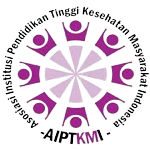- Focus and Scope
- Section Policies
- Peer Review Process
- Open Access Policy
- Publication Ethics
- Article Template
- Author Guidelines
- Article Processing Charges
- Plagiarism Check
- Archiving
Focus and Scope
Jurnal Pelayanan dan Pengabdian Kesehatan untuk Masyarakat is a Community Service (PkM) journal written in both Indonesian and English. This journal aims to publish manuscripts derived from community service activities. We expect findings from community service activities to be included in every manuscript submitted to our journal. Manuscripts submitted to the Jurnal Pelayanan dan Pengabdian Kesehatan untuk Masyarakat may include the results of community service activities in the following areas: 1. Enhancing the Community's Creative Industry 2. Developing and Utilizing Local Wisdom 3. Developing the Economy, Entrepreneurship, Cooperatives, and MSMEs 4. Developing and Utilizing Science and Technology 5. Developing Human Resources 6. Improving Public Health
Section Policies
Articles
Peer Review Process
This journal provides immediate open access to its content on the principle that making research freely available to the public supports a greater global exchange of knowledge.
Open Access Policy
This journal provides immediate open access to its content on the principle that making research freely available to the public supports a greater global exchange of knowledge.
Publication Ethics
Jurnal Pelayanan dan Pengabdian Kesehatan Untuk Masyarakat is a review journal published by the Institute for Research and Community Service, Universitas Respati Indonesia. This statement describes the ethical behavior of all parties involved in the process of publishing articles in this journal, including authors, editor-in-chief, editorial board, reviewers and publishers.
Journal Publication Ethics Guidelines
The publication of reviewed articles in the Jurnal Pelayanan dan Pengabdian Kesehatan Untuk Masyarakat is an important foundation in developing a coherent and recognized knowledge network. This is a direct reflection of the quality of the author's work and the institutions that support it. The articles reviewed support and embody the scientific method. Therefore, it is important to agree on ethical standards that are expected for all parties involved in the act of publishing: authors, journal editors, best partners, publishers, and the public.
The Institute for Research and Community Service (LPPM) Universitas Respati Indonesia as the publisher of the Jurnal Pelayanan dan Pengabdian Kesehatan Untuk Masyarakat takes the task of taking care of all stages of publishing very seriously and we are aware of our ethics and other responsibilities. We are committed to ensuring that advertising, reprint or other commercial revenue does not influence or influence editorial decisions. In addition, the Institute for Research and Community Service (LPPM) Universitas Respati Indonesia and the Editorial Board will assist in communication with other journals and/or publishers if necessary.
Publication Decision
The Editorial Team of the Jurnal Pelayanan dan Pengabdian Kesehatan Untuk Masyarakat is responsible for deciding which articles to publish. Validation of work and its importance to researchers and readers should always drive that decision. Editors can be guided by the policies of the journal's editorial board and are limited by applicable legal provisions, such as defamation, copyright infringement, and plagiarism. Editors may negotiate with other editors or best partners in making this decision.
Aspects of justice
The Editorial Team evaluates manuscripts over time for the author's intellectual content regardless of the author's race, gender, sexual orientation, religious beliefs, ethnicity, nationality, or political views.
Confidentiality
The Editorial Team and any editorial staff may not disclose any information about the submitted text to anyone other than the authors, reviewers, prospective reviewers, other appropriate editorial boards and publishers, as appropriate.
Disclosure and Conflict of Interest
Unpublished material in the submitted text may not be used in the editor's own manuscript without the written consent of the author.
Review Tasks
Contribute to Editor's Team Decision
Bestari partners help editors make editorial decisions and can help writers improve manuscript quality through editors.
Speed
Any selected reviewers who feel that they do not meet the requirements/interests to review the text or do not have sufficient time to study it must immediately notify the editor and withdraw from the review process.
Confidentiality
Any text received for review must be treated as a confidential document. Manuscripts may not be distributed or discussed with others unless authorized by the editor.
Objectivity Standard
Review must be done objectively. Personal criticism of the author is not appropriate to convey. Reviewers must express their views clearly with supporting arguments.
Source Acknowledgment
Reviewers should identify works from relevant publications that have not been cited by the authors. Statements that previously reported observations, derivations or arguments must be accompanied by relevant citations. The reviewer must also state to the editor if there are substantial similarities or overlaps between the text under consideration and other published articles.
Disclosure and Conflict of Interest
Information or ideas obtained during the review process must be kept confidential and not used for personal gain. Reviewers must reject texts that have conflicts of interest due to competition, collaboration, or other relationships and connections with any of the authors, companies, or institutions associated with the text.
Fundamental Mistakes in Published Work
When the author discovers significant errors or inaccuracies in the published work, it is the duty of the author to immediately notify the journal editor or publisher and cooperate with the editor to retract or correct the manuscript.
Editorial Board of the Jurnal Pelayanan dan Pengabdian Kesehatan Untuk Masyarakat, Universitas Respati Indonesia (URINDO)
Jl. Bambu Apus I No. 3 Cipayung, East Jakarta.
Email: jukmas@urindo.ac.id; lppm@urindo.ac.id
Article Template
ARTICLE TITLE (no more than 20 words, using Capital Each Word, 14 pt, bold, center), written in Indonesian
Lead Author1, Co-Author 1, and Co-Author 2(11pt)
1writer position in the first supporting institution (11pt)
2 author positions in secondary support institutions, if any (11pt)
lead author email address (11pt)
Abstract (maximum 250 words)
Keywords: ............................................... .................................. (3-9 words; calibre 11 pt)
Abstract
Keywords : 3-9 keywords in English (11 pt, italics)
INTRODUCTION (11 PT, BOLD)
The paper is written in Calibri, size 11 and in A4 (210mm x 297mm) document format with 2.5 cm top margin, bottom: 2cm, left 2.5 cm and right: 2 cm, aligned right – left. The contents of the document, including tables, graphs, images, should not exceed 10 pages. The title should be short, informative and no more than 20 words. Articles are divided into two columns.
The introduction contains the background of why the research was conducted, problem formulation, literature review and information related to the writing. The part of the introduction is the background, problem formulation, research objectives and research benefits
METHOD
Contains the research design, descriptions of the methods of carrying out research including population and samples, instruments and methods of data collection, data analysis techniques. Results present
characteristics of the data and research findings.
RESULTS AND DISCUSSION
The results of the study contain a brief statement about the results of the study. While the discussion contains a discussion that connects and compares the research results with the theory and results of previous studies.
QUOTATION: Writing citations by mentioning the source, namely by writing the author's last name accompanied by the year of publication of the book. Quotations can be done in a direct way, summarizing.
TABLE: The title of the table is written in size 11, bold. Like the example below. Numbering table names using Arabic numbers. There is no space between the title of the table and the table. The contents of the table are written in Calibri font size 11, and in 1 space format. While the Image Title is placed under the image in a format like the table title.
Table 2. Analysis of Respondents Characteristics
RT Clean and Healthy Living Behavior
With PHBS Not in PHBS
1 45 76
2 17 23
3 12 23
4 47 30
5 24 16
6 12 18
Total 157 186
Source: Health Center Profile
Pasar Rebo . District
Figure 1. Survival curve of PLWHA with
Treatment Compliance.
CONCLUSION
The closing section consists of Conclusions and Suggestions based on research results
CLOSING (IF ANY)
Contains acknowledgment or thanks to parties who play a role and are involved in the implementation of research/article writing (donors/sponsors), both material and other facilities.
REFERENCES (11 PT, BOLD)
All articles referred to are written in the Bibliography with the following provisions (Vancouver System) as follows: The space used is 1 space, the second line of each article starts indenting with 6 beats. The distance between articles is 1 space. Order of Writing Articles by number. The author's name is written without a title, starting with the last name (family name) written in full followed by the first name written in an abbreviation and does not need to be sorted alphabetically. No need to sort the year of publication of the article. Use of bibliography for the last 10 years for references from books and the last 5 years for journals.
(only written in accordance with the citations listed in the publication manuscript only)
It is recommended to use Reference Management Tool Applications such as Mendeley and others.
Selengkapnya tentang teks sumber iniDiperlukan teks sumber untuk mendapatkan informasi terjemahan tambahan
Author Guidelines
PANDUAN PENULISAN NASKAH
JURNAL PELAYANAN DAN PENGABDIAN KESEHATAN UNTUK MASYARAKAT (JPPKM)
Jurnal Pelayanan dan Pengabdian Kesehatan untuk Masyarakat menerima tulisan karya ilmiah original (artikel, tinjauan/review, laporan studi kasus, tinjauan buku, atau hal yang berkaitan dengan kelompok rumpun ilmu kesehatan. Artikel tersebut belum diterbitkan atau dalam proses diajukan untuk dimuat pada suatu jurnal atau majalah lain.
PEER REVIEW ARTIKEL
Artikel yang sudah dikirim ke jurnal akan dilakukan review terkait teknis penulisan dan subtansi dari artikel oleh minimal 2 (dua) orang reviewer.
ORISINALITAS DAN PLAGIARISME
Penulis artikel harus memastikan bahwa naskah yang dikirim adalah karya sendiri dan bebas plagiat. Semua naskah yang akan dipublikasi akan dicek similaritasnya menggunakan software antiplagiarisme.
1. Sistematika Penulisan
- Bagian awal : judul (maksimal 20 kata; 14 pt), nama penulis (tanpa gelar), asal instusi/lembaga, email, abstrak (ditulis dalam Bahasa Indonesia dan/atau Bahasa Inggris. Abstrak disusun dengan jumlah kata tidak melebihi 250 kata dengan menggunakan jenis huruf Calibri ukuran 11 pt spasi tunggal. Pada halaman abstrak dicantumkan kata kunci (keywords) minimum 3 kata dan maksimum 9 kata).
- Bagian utama : berisi pendahuluan, kajian literatur dan pengembangan hipotesis (jika ada), cara/metode penelitian, hasil penelitian dan pembahasan, dan kesimpulan dan saran.
- Bagian akhir : ucapan terima kasih, keterangan simbol (jika ada), dan daftar pustaka
2. Tata Letak
Naskah ditulis pada kertas A4 dengan format marjin sebagai berikut:
- Marjin atas 2,5 cm
- Marjin bawah 2,5 cm
- Marjin Kiri 2,5 cm
- Marjin Kanan 2,5 cm
Setiap naskah maksimum 10 halaman (termasuk tabel, gambar, dan daftar rujukan) dengan jarak spasi tunggal, jenis huruf Calibri, ukuran 11 pt.
b. Bahasa, Satuan, dan Lambang
Naskah ditulis dalam Bahasa Indonesia baku, lugas dan jelas. Penggunaan satuan dan lambang mengacu pada aturan Standar Nasional dan Satuan Internasional (SI).
Penulisan Persamaan
Persamaan atau rumus ditulis menggunakan software equestion dan diberi nomor, sebagai contoh:
Ω = 2 πr ……………………………. (1)
Penulisan persamaan dalam teks dinyatakan dengan Pers. (1).
Gambar dan Tabel
Gambar dan Tabel dicetak dengan warna hitam-putih. Penulisan gambar dan tabel seperti contoh di bawah ini.
Gambar 1. Keterangan gambar (ditengah bawah) dan Tabel 1. Keterangan Tabel (di tengah atas). Dalam teks ditulis Gbr. 1. dan Tabel 1.
3. Daftar Acuan
Daftar acuan ditulis sesuai urutan penunjukkan pada naskah dengan menggunakan Sistem Vancouver (angka dalam kurung siku). Acuan memuat inisial dan nama penulis (anonym), nama jurnal atau nama buku, volume, editor, penerbit, kota, tahun, dan halaman.
Contoh Daftar Acuan:
Paper dalam Jurnal
[1] E. Yusron. Jurnala Makara Sains 10, (2006) 41.
[2] G. Smith. Thin Solid Films (to be published).
Publikasi Elektronik, Informasi Internet
[3] S. Auzary, K.F. Badawi, L. Bimbault. Phys. Rev. Lett. 68 (2008) 2912. Hep-th/9112009.
[4] L. Weiss. Instruction to Authors, Elsevier Publishing, http:/www.elsevier.com/authors.html 1999.
Publikasi Prosiding Konfrensi
[5] C.H. Perry, F. Lu, F. Namavar, N.M. Kalkhoran. Material Res. Soc. Symp. Proc. 256 (2005) 132.
[6] J.J. Favier, D. Camel. Proceedings of the Eight International Conference on Crystal Growth, York, U.K., 2006, p.58.
Monograf, Buku yang diedit
[7] D. Falix [Ed.]. Handbook of Optical Constants of Solid II,3rd Ed., Academic Press, New York, 1991, p.253.
[8] S.M. Sze. The Physics of Semiconductor Device, Wiley, New York, 1981, p. 345.
Skripsi, Tesis, Disertasi
[9] R. Ramos. Ph.D. Thesis, College van Dekanen, University of Twente, Netherland, 1991.
[10] S. Badu. Skripsi Sarjana, Jurusan Kimia FMIPA, Universitas Indonesia, 2008.
Patent
H. Yamagushi, A. Hiroe, H. Nishio. Japan Patent No. 5264701, 23 Nov.1993.
Paper Laporan Industri
[11] R.D. Nicholson. International Structures in Nickel-based Transitions Joints After Long Term Service, Report RD/M/N1131, Central Electricity Generating Board, Marckwood, 2005.
[12] J. Cleveland. Spring Constant Update, Digital Instrument, Santa Barbara, 1987. [Jika ada alamat Website dapat ditambahkan dengan huruf Italic]
Data Khusus [Jika penulis suatu tim atau sinonim]
[13] Joint Committee on Powder Diffraction Standards, Powder Diffraction File, ASTM, Philadelphia, 1967, Card 4301027.
[14] Anonim. 19th Annual Book of ASTM Standards Part 17, ASTM Philadelphia, 1969, p. 457.
Hasil yang tidak dipublikasikan (diacu jika sangat diperlukan)
[15] D.H. Smith. Physics Departement, Chicago University, Chicago, U.S.A., Private Commun, 1966.
[16] R. Stumpf, X. Gonze. Fritz-Haber Institute Research Report, 2006, Unpublished.
4. Cara Pengiriman Naskah
Pada jurnal yang telah menerapkan Open Journal Systems (OJS), pengiriman manuskrip atau naskah dapat dilakukan melalui aplikasi tersebut secara online yang dikenal dengan istilah online submission.
Pendaftaran dan Submit online: http://ejournal.urindo.ac.id/index.php/jppkm
C.p: 08122504356; 089691155082
Article Processing Charges
This journal charges the following author fees. Article Submission: 0.00 (IDR) Authors are required to pay Article Submission Fees as part of the submission process to contribute to review fees. Fast Track Reviews: 0.00 (IDR) With payment of these fees, reviews, editorial decisions and author's notices in this manuscript are guaranteed to take place within 4 weeks. Publication Article: Rp 0.00 (IDR)
Plagiarism Check
Plagiarism is a threat to scientific publishing in general and Jurnal Pelayanan dan Pengabdian Kesehatan untuk Masyarakat in particular. The originality of submitted work can be ensured through plagiarism screening and rejection of suspected material. For maximum effectiveness, all articles submitted to Jurnal Pelayanan dan Pengabdian Kesehatan untuk Masyarakat must go through a plagiarism detection process before submission.
Archiving
Jurnal Pelayanan dan Pengabdian Kesehatan untuk Masyarakat provides immediate open access to its content, based on the principle that making research publicly available supports a broader global exchange of knowledge. Published articles will be available on theJurnal Pelayanan dan Pengabdian Kesehatan untuk Masyarakat website, and the full text can be downloaded free of charge. * PKP Publication Network (PKP PN). See info. * Portico archive.












